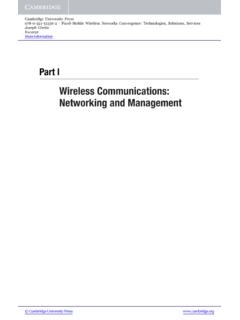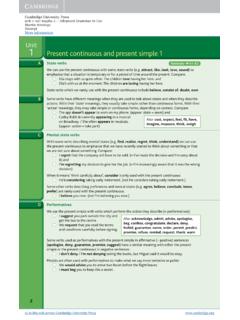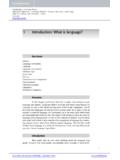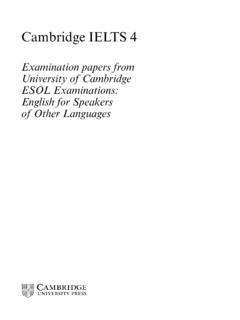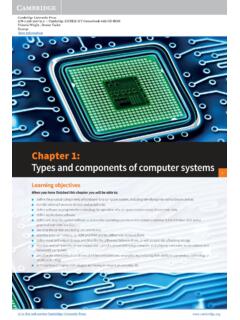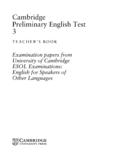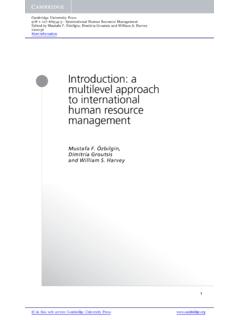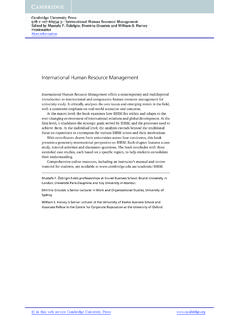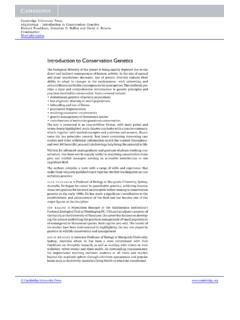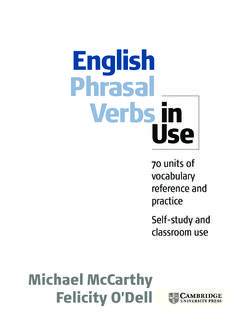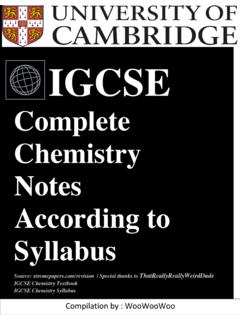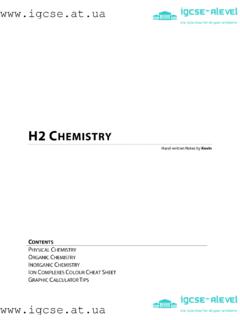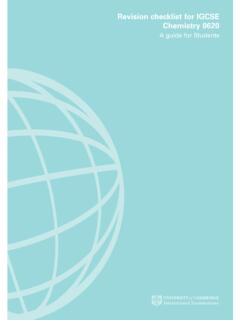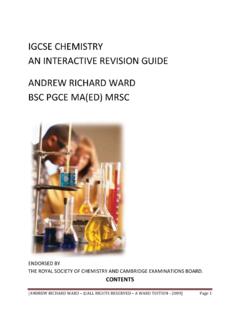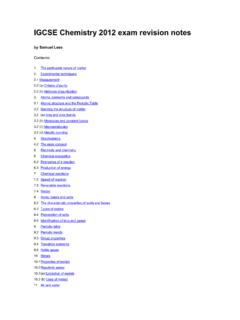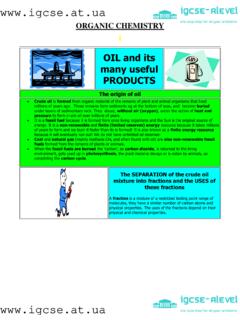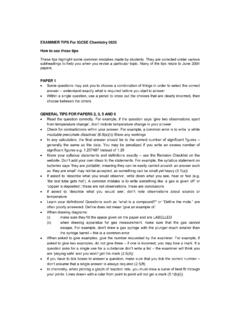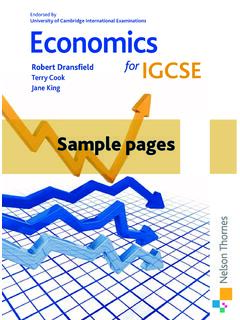Transcription of Richard Harwood and Ian Lodge Chemistry - Assets
1 Cambridge University Press978-1-107-61503-8 Cambridge IGCSE ChemistryRichard Harwood and Ian LodgeFrontmatterMore information in this web service Cambridge University Harwood and Ian Lodge Cambridge IGCSE ChemistryCoursebook Fourth edition in this web service Cambridge University Printing House, Cambridge cb bs, United KingdomCambridge University Press is part of the University of Cambridge. It furthers the University s mission by disseminating knowledge in the pursuit of education, learning and research at the highest international levels of Cambridge University Press This publication is in copyright. Subject to statutory exception and to the provisions of relevant collective licensing agreements, no reproduction of any part may take place without the written permission of Cambridge University published Second edition Third edition Fourth edition Printed in the United Kingdom by Latimer TrendA catalogue record for this publication is available from the British Libraryisbn - - - - Paperback with CD-ROM for Windows and Mac Cambridge University Press has no responsibility for the persistence or accuracy of URLs for external or third-party internet websites referred to in this publication, and does not guarantee that any content on such websites is, or will remain, accurate or appropriate.
2 Information regarding prices, travel timetables, and other factual information given in this work is correct at the time of first printing but Cambridge University Press does not guarantee the accuracy of such information to teachers in the ukIt is illegal to reproduce any part of this work in material form (includingphotocopying and electronic storage) except under the following circumstances:(i) where you are abiding by a licence granted to your school or institution by theCopyright Licensing Agency;(ii) where no such licence exists, or where you wish to exceed the terms of a licence, and you have gained the written permission of Cambridge University Press;(iii) where you are allowed to reproduce without permission under the provisions of Chapter of the Copyright, Designs and Patents Act , which covers, for example, the reproduction of short passages within certain types of educational anthology and reproduction for the purposes of setting examination end-of-chapter questions taken from past papers are reproduced by permission of Cambridge International answers and all other end-of-chapter questions were written by the author.
3 IGCSE is the registered trademark of Cambridge International International Examinations bears no responsibility for the example answers to questions taken from its past question papers which are contained in this of the Cambridge IGCSE Chemistry syllabus included in this resource are reproduced by permission of Cambridge International Examinations. in this web service Cambridge University v1 Planet Earth Natural cycles and resources Th e atmosphere Seas and rivers Th e Earth s crust 142 The nature of matter Th e states of matter Separating and purifying substances Atoms and molecules Th e structure of the atom Electron arrangements in atoms 473 Elements and compounds Th e Periodic Table classifying the elements Trends in groups Trends across a period Chemical bonding in elements and compounds Th e chemical formulae of elements and compounds Metals.
4 Alloys and crystals 784 Chemical reactions Chemical reactions and equations Equations for chemical reactions Types of chemical reaction A closer look at reactions, particularly redox reactions Electrolysis A closer look at electrode reactions 1135 Acids, bases and salts What is an acid? Acid and alkali solutions Metal oxides and non-metal oxides Acid reactions in everyday life Alkalis and bases Characteristic reactions of acids Acids and alkalis in chemical analysis Salts Preparing soluble salts Preparing insoluble salts Strong and weak acids and alkalis 1436 Quantitative Chemistry Chemical analysis and formulae Th e mole and chemical formulae Th e mole and chemical equations Calculations involving gases Moles and solution Chemistry 1677 How far? How fast? Energy changes in chemical reactions Rates of reaction Catalysts Photochemical reactions Reversible reactions and chemical equilibria 1948 Patterns and properties of metals Th e alkali metals Aluminium Th e transition elements Th e reactivity of metals Electrical cells and energy 2219 Industrial inorganic Chemistry Th e extraction of metals by carbon reduction Th e extraction of metals by electrolysis Ammonia and fertilisers Sulfur and sulfuric acid Th e chlor alkali industry Limestone Th e economics of the chemical industry 245 in this web service Cambridge University IGCSE Chemistryiv10 Organic Chemistry Th e unique properties of carbon Alkanes Alkenes Hydrocarbon structure and isomerism Chemical reactions of the alkanes Chemical reactions of the alkenes Alcohols Th e reactions of ethanol Organic acids
5 And esters 26911 Petrochemicals and polymers Petroleum Alternative fuels and energy sources Addition polymerisation Condensation polymerisation 28712 Chemical analysis and investigation Inorganic analysis Organic analysis Experimental design and investigation Practical examinations 310 Answers to questions 326 Glossary 336 Appendix: The Periodic Table 346 Index 347 Acknowledgements 353 Terms and conditions of use for the CD-ROM 354CD-ROMS tudy and revision skills Self-assessment practice tests Practice exam-style papers and marking schemes Syllabus contents table Syllabus coverage by book chapter Glossary Notes on Activities for Teachers/Technicians Self-assessment checklists Activities Answers to Coursebook end-of-chapter questions Revision checklists Animations in this web service Cambridge University is a laboratory science: its subject material and theories are based on experimental observation.
6 However, its scope reaches out beyond the laboratory into every aspect of our lives to our understanding of the nature of our planet, the environment we live in, the resources available to us and the factors that aff ect our is book thoroughly covers the Cambridge International Examinations (IGCSE) Chemistry syllabus and includes features which are aimed at helping you grasp the concepts and detail involved. Th e areas that cover the Core and Supplement material of the syllabus are clearly marked (the Supplement material having a purple bar like the one here in the margin) so that you can see which topics will be tested on each exam paper that you will take. Th e topic summaries, questions and end-of-chapter questions are also clearly marked so that you can pick out, study and revise the material relevant to the core and extended addition to covering the syllabus, the book also contains additional information.
7 Th is will not be examined, but is there to help develop your scientifi c skills and broaden your knowledge. Areas of additional information are marked by the green bar like the one here in the e fi rst chapter of the book serves to set Chemistry in its broader context and as such contains material that sets the scene as well as syllabus material. At various points in this and other chapters there is material that provides and develops some of the context in which chemical ideas are important. Th ese are areas such as: the importance of Chemistry to life, and the nature of the universe (Chapter 1) renewable and non-renewable resources (Chapter 1) our need to develop alternative energy sources (Chapter 11).Th e introduction to each chapter aims to highlight some of the more novel aspects of Chemistry from unusual alloys and the visualisation of the bonding in molecules to the analytical laboratory on the surface SAof Mars.
8 Th e introductions are found in boxes and as with the additional information, the material within these will not be of the book and the Student CD-ROMTh e book is divided into broad chapters covering important areas of the syllabus. Th ese chapters are then divided into diff erent sections to help you manage your understanding of the ideas involved. At the end of each section there are short questions to help you check that you have followed the ideas covered. Th e answers to these short questions are provided at the end of the book to help you with this. Included in the text are a series of study tips and key defi nitions. Th ese highlight important areas of learning and useful approaches to a particular chapter fi nishes with a summary of Core and Supplement material to help you particularly with your revision. Th is is followed by a selection of end-of-chapter questions which are there to help you become familiar with the style of question set in each questions is a great way to get to grips with each of the topics.
9 However, it is not the only way! Th e Student CD-ROM provides information on revision skills and resources available on the internet to help with your study of Chemistry . A copy of the syllabus is provided on the CD-ROM, which shows where the diff erent topics are covered in the book and you can use this interactively as a checklist during revision. Mind-mapping ideas and other revision strategies are discussed on the CD-ROM, and we hope that you can fi nd ideas that will help you study in the most personally eff ective important feature which appears both in the book and on the Student CD-ROM is the glossary. Th e terms included in the glossary are highlighted in the text in dark red bold. Do use this resource in in this web service Cambridge University IGCSE Chemistryviaddition to the text in order to help you understand the meaning of chemical terms. But more than that, it is important that you can express your ideas clearly in an exam that is why we have included so many practice questions in the book and in the practice tests that appear on the CD-ROM.
10 Th e information boxes and key defi nitions placed throughout the chapters are there to help you learn how to summarise your knowledge in an eff ective and clear way. Chemistry , and science in general, can oft en use certain words in a very precise way, so it is important to read carefully and get used to writing down your answers clearly. Practical workWe began by saying that Chemistry was a practical science and, in this edition, we have included Activities throughout the chapters, which we hope will encourage your enjoyment of the practical aspect of the subject. Worksheets for these practicals are included on the Student CD-ROM. In addition, we have aimed to help your preparation for the practical element of the exam in various ways: Chapter 12 of the book gives a summary of the diff erent ways that practical work is assessed and some exemplar questions. Th ere are practice alternative to practical papers (Paper 6) on the Student CD-ROM.
